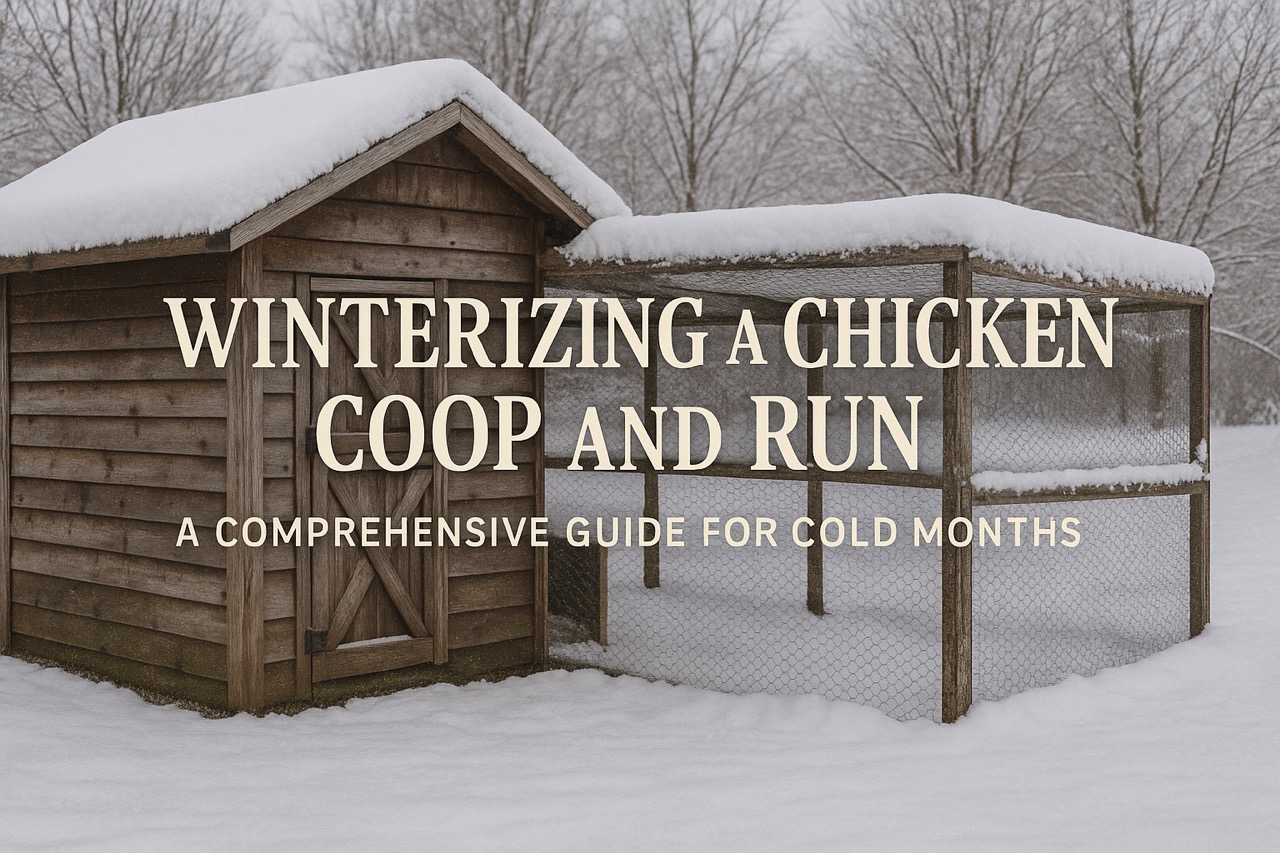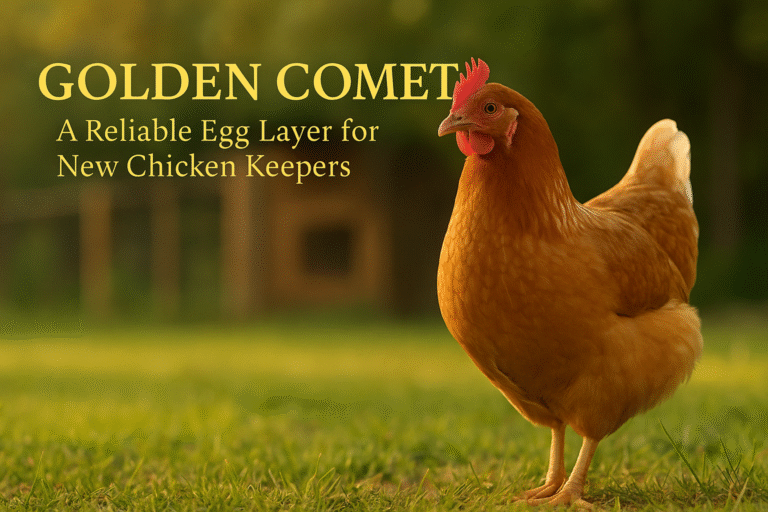Winterizing a chicken coop and run is essential for keeping your flock warm, safe, and productive during cold weather. Whether you’re preparing for light frost or deep winter storms, proper insulation, ventilation, and run protection will make all the difference. This comprehensive guide walks you through everything you need to know to protect your chickens from the chill — including frostbite prevention, bedding tips, water solutions, and more.
🏡 1. Deep Clean Before Winterizing Your Chicken Coop
Why it matters: Cleaning out bacteria, parasites, and moisture-trapping waste before winter sets in reduces respiratory risks and keeps the coop healthy.
- Remove all bedding and thoroughly scrub floors, roosts, and nesting boxes.
- Disinfect with a poultry-safe solution.
- Inspect for gaps, broken boards, or damage that could allow drafts or pests in.
❄️ 2. Insulating and Ventilating When Winterizing a Coop
Insulation tips:
- Use foam boards, straw bales, or extra wall panels to retain heat.
- Apply the deep litter method: layer dry bedding and allow composting to naturally generate warmth.
Ventilation tips:
- Add vents high on walls to let moisture escape without chilling birds.
- Never fully seal the coop; humidity = frostbite risk.
Target temperature: Keep the coop between 1–4°C (34–39°F).
🧹 3. Add Extra Bedding
Thick bedding of straw, hemp, or pine shavings insulates the floor and gives chickens a warm surface to rest.
- Check bedding daily.
- Replace any wet spots.
- Layer deeper as temperatures drop.
💡 4. Add Supplemental Lighting (Optional)
If you want to maintain egg production:
- Provide 14–16 hours of light per day using a safe, low-wattage bulb.
- Use a timer to avoid stressing the flock.
Do not use heat lamps—they pose a fire risk.
🚰 5. Winter-Proof Water Systems for Chickens
Best solutions:
- Heated waterers
- Submersible de-icers
- Rubber tubs + heated bases
No electricity?
- Replace water several times a day
- Use insulated containers
- Keep in sun or out of wind
Chickens need fresh water at all times to stay healthy.
🌮 6. Increase Calories and Protein
Chickens burn more energy staying warm.
What to feed:
- Layer feed + added scratch grains (especially corn at night)
- High-protein treats like mealworms and sunflower seeds
Why: Extra calories = extra warmth overnight
❄️ 7. Prevent Frostbite
- Apply petroleum jelly to combs/wattles in extreme cold
- Keep coop dry with proper airflow
- Use wide wooden roosts so chickens can cover their feet with feathers
Chickens are most at risk below -3°C (27°F) if moisture is present.
🌨️ 8. Limit Free-Ranging in Harsh Conditions
- Below -6°C (21°F)? Keep chickens inside or in covered run
- Provide windbreaks using hay bales or tarps
- Clear snow paths and lay down straw or chips for footing
🌫️ 9. Block Drafts, Not Airflow
- Seal cracks near the floor or roosting zone
- Leave upper vents open for safe airflow
- Use weatherstripping, caulking, or plywood to seal gaps
♥️ 10. Monitor Flock Health
Check birds daily for:
- Changes in behavior or appetite
- Limping, feather loss, or signs of frostbite
- Reduced egg production or signs of stress
Avoid introducing new birds during winter to minimize stress.
🛌 11. Provide Safe Roosting Space
- Use 2″x4″ wooden bars with flat side up
- Place 2–3 ft off the ground
- Ensure enough space for every bird to roost without crowding
Roosts help chickens stay off cold floors and preserve body heat.
🌟 12. Add Winter Entertainment
Bored chickens = stressed chickens.
Try:
- Hanging cabbages
- Pecking blocks
- Dust baths in bins with ash or sand
- Scatter feeding to encourage foraging
🏠 13. Winterizing a Chicken Run for Cold-Weather Comfort
Cover exposed areas with clear plastic or tarp
- Let light in, block wind and snow
- Use deep litter bedding outside too (straw, chips, leaves)
- Create small shelters or lean-tos inside run with hay bales or dog crates
⛄️ 14. Manage Snow and Ice
- Shovel snow paths in the run
- Add straw on top of snow to make it walkable
- Use sand or ash on icy spots to prevent slipping
⚡️ 15. Why Heat Lamps Aren’t Needed When Winterizing Your Coop
Heat lamps cause fires more than they help. Instead:
- Rely on insulation, ventilation, and calories
- Only use heat in rare emergencies and never unsupervised
🌿 Conclusion: Let Your Chickens Thrive in Winter
Winterizing your chicken coop and run is about preparation, not panic. With a clean, insulated coop, proper bedding, warm roosts, and moisture control, your flock can stay safe and happy all season long.
Monitor water, feed, and health daily—and give them a few fun things to peck at along the way.
🔗 Further Reading on Paranoid Prophet
- 🧼 Optimal Chicken Feeder Placement
Learn how elevation, location, and coop layout affect feed hygiene, waste reduction, and winter prep. - 🐓 How Many Chickens to Start With
Plan your winter setup smarter by choosing the right flock size for your space, budget, and climate. - 🛡️ Sacred Stewardship: Backyard Chickens
A deeper look at how winter care reflects our call to protect, provide, and steward God’s creatures well. - 🐾 Broody Hen Solutions
Understand how seasonal changes and winter stress may affect egg-laying cycles and broody behavior. - ❄️ Backyard Chickens and Ethical Living
How cold-weather care decisions reflect larger values around sustainability, creation care, and responsibility. - 🐛 Chickens and Natural Pest Control
See how winter changes your chickens’ pest control role and what to do when foraging slows.
🌐 External Related Reading
- 5 Steps to Winterize Your Chicken Coop | Grubbly Farms
- How to Winterize Your Chicken Coop and Run | City Life to Farm Life
- Winterizing the Chicken Coop and Run | The Half-Ass Homestead
- Winterizing Chicken Coop: 6 Super Simple Steps | Chicken Coop Company
- Winterizing the Chicken Coop | High Plains Journal
❄️ Winter Chicken Coop and Run FAQ
1. Do chickens need heat in the coop during winter?
Not usually. Most chicken breeds tolerate cold well if they’re dry, draft-free, and have proper insulation. Avoid heat lamps due to fire risk. Instead, use the deep litter method, draft protection, and high-energy feed.
2. How do I keep chicken water from freezing in winter?
Use heated waterers, submersible de-icers, or heated bases for rubber bowls. If power isn’t available, check and refill water multiple times daily and use black rubber tubs to retain warmth on sunny days.
3. What’s the best bedding for chickens in cold weather?
Pine shavings, straw, or hemp are ideal for warmth and absorbency. Use the deep litter method for added insulation by letting clean layers build up over time.
4. How can I prevent frostbite on my chickens’ combs and wattles?
Keep humidity low by ventilating the coop (vents high on walls), apply a thin coat of petroleum jelly on large combs, and avoid wet bedding or freezing water drips.
5. Should I add a light to the coop in winter?
Yes—if you want to maintain egg production. Use a low-wattage LED on a timer to provide 14–16 hours of total light. Make sure the setup is secure and doesn’t increase fire risk.
6. Can chickens go outside in the snow?
Yes, but they may avoid deep snow. Shovel paths, add straw or wood chips, and provide windbreaks. Keep them inside during extreme cold (below -6°C / 21°F).
7. How do I winterize the chicken run?
Cover open sides with clear plastic sheeting or tarps to block wind and snow. Add thick straw or wood chips, and create sheltered zones with hay bales, bins, or A-frame structures.
8. How often should I clean the coop during winter?
Spot-clean wet areas daily. Full deep litter systems can go longer between cleanings, but refresh the top layer weekly and do a full clean if ammonia or mold develops.
9. Can I use the deep litter method in the run?
Yes—especially in covered areas. Pile up straw, leaves, or wood chips. It will insulate feet, reduce mud, and slowly compost to generate warmth.
10. What’s the ideal roost setup for winter?
Use 2×4 wood bars (flat side up) at least 2–3 feet off the ground. This allows chickens to cover their toes with feathers while roosting, reducing frostbite risk.




